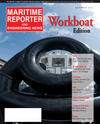
Page 32: of Maritime Reporter Magazine (November 2011)
Feature: Workboat Annual
Read this page in Pdf, Flash or Html5 edition of November 2011 Maritime Reporter Magazine
BY EDWARD LUNDQUIST As Director of Innovation, Dr. Larry Schuette is one of three portfolio direc-tors at the Office of Naval Research (ONR). His counterparts are the directorof research (discovery and invention) and director of transition. The Office of In- novation promotes, fosters, and develops innovative science, technology, processes and policies that support the Departmentof the Navy. ?I manage the ?leap ahead? portfolio here at the Office of Naval Research,? he said.Schuette leads both technological inno-vation in as well as the business of inno- vation. ?Our team manages ?quick reaction? technology and acquisition en- ablers to provide rapid and agile re- sponses for critical warfighter needs,? Schuette says.That includes Innovative Naval Proto- types (INPs), which push the boundariesof our nation?s technical talent to deliver transformational warfighting capabilities to the U.S. Navy and Marine Corps. [The Department of Defense (DoD) catego- rizes research, development, test, and evaluation (RDT&E) activities by budget authority in three categories: 6.1 is basic research; 6.2 is applied research; and 6.3is advanced technology development. In- novative Naval Prototypes explore high 6.2 and 6.3 technologies that can dramat-ically change the way naval forces fight. INPs are not programs of record, but they do reduce the acquisition risk of these new and disruptive technologies and capabilities, he says. ?Some of ourINP programs include the Electromag-netic Railgun (EMRG); the Free ElectronLaser (FEL); Persistent Littoral UnderseaSurveillance (PLUS); the Transformable Craft (T-Craft) Sea Base Enabler; and the Tactical Satellite (TACSAT) series of spacecraft.? ?The SwampWorks program is part of my portfolio,? he says. ?Swamp- Works explores innovative, high-risk and disruptive technologies and con- cepts, and leverages short exploratory studies to examine the maturation of aproposed technology before making substantial investments. These efforts are smaller in scope than INPs and are intended to produce results in less than three years.? As an example, Schuette says ONR previously designed unmanned surface vessels to be used as minesweepers, ?so we can get away from using ships to tow mine countermeasures equipment inminefields. Taking another look we?ve found that the investment we?ve made in high-temperature superconducting de-gaussing equipment?to protect surface ships from magnetic influence mines?also has applications for being used re-motely to detonate those mines. While high risk, the research may have signifi- cant impact.? The Innovation portfolio also involves the Massive Multiplayer Online Wargame Leveraging the Internet ? or MMOWGLI ? exercise, a joint effort between ONR, Naval Postgraduate School (NPS) and Institute for the Future(IFTF). This open online wargame uses crowdsourcing to get a wide range of ideas ideas and strategies that may pro- vide insight to some of the Navy's tough- est problems. TechSolutions is a transformational business process that provides Sailors and Marines with a web-based tool forbringing technology needs to the Naval Research Enterprise for rapid responseand delivery. ?One of the best ways to provide that quick reaction capability to warfighters is to hear about what they need and their ideas about solving problems from themdirectly,? Schuette says. ?Through our TechSolutions program we invite Sailors and Marines in the fleet and in the field to bring us their problems and ideas, so wecan put the S&T community to work for them. It produces tangible results.? (See related Tech Solutions story, pg. 38) INNOVATIVE NAVAL PROTOTYPES We?ve developed a series of satellites that pack a lot of capability into a smallsize, and have allowed us to prototype new concepts quickly and get them into space. We just launched TacSat-4, a small UHF communications relay satel-lite that allows a Marine on the ground to use a hand-held UHF radio with rangespreviously unheard of. This satellite packs a lot of power into as very small space, and has one of the most advanced thermal systems ever flown. We?ve also developed a Virtual Mission Ops Center (VMOC) that allows for a lot of automa- tion and flexibility for mission planning. We?ve learned a lot with this satellite, and we?ve also given the warfighter a new and much-needed capability.? The T-Craft?or Transformable Craft INP being developed by ONR is a ?seabasing enabler.? It had to be self de- ployable and deliver cargo from the sea base to shore ?feet-dry,? which means discharge its payload up to the beach, be- yond the surf and onto dry land; and thenrepeat the process to continue delivering very specific cargo where needed. Several designs have been produced for ships that can self-deploy without a payload up 2,500 nautical miles unre- fueled at a speed of 20-plus knotsthrough sea state 5.; meeting up with the sea base; taking on up to 750 tonsof cargo?including vehicles as large as M1A1 tanks?in high sea states;and then deliver that payload from the sea base to shore at high speed (more than 40 knots), then discharge the pay- load ?feet dry? over the surf and onto dry land; and then repeat the process tocontinue delivering very specific cargo distributed where needed, all without port facilities. The three designs show the concept is feasible.32Maritime Reporter & Engineering News OFFICE OF NAVAL RESEARCH FEATURE ONR Director of Innovation: We?re trying to create the alternate future From Science Fiction to Science Fact Dr. Larry Schuette, Director of Innovation, ONR MR Nov.11 # 4 (25-33):MR Template 10/27/2011 9:20 AM Page 32

 31
31

 33
33
